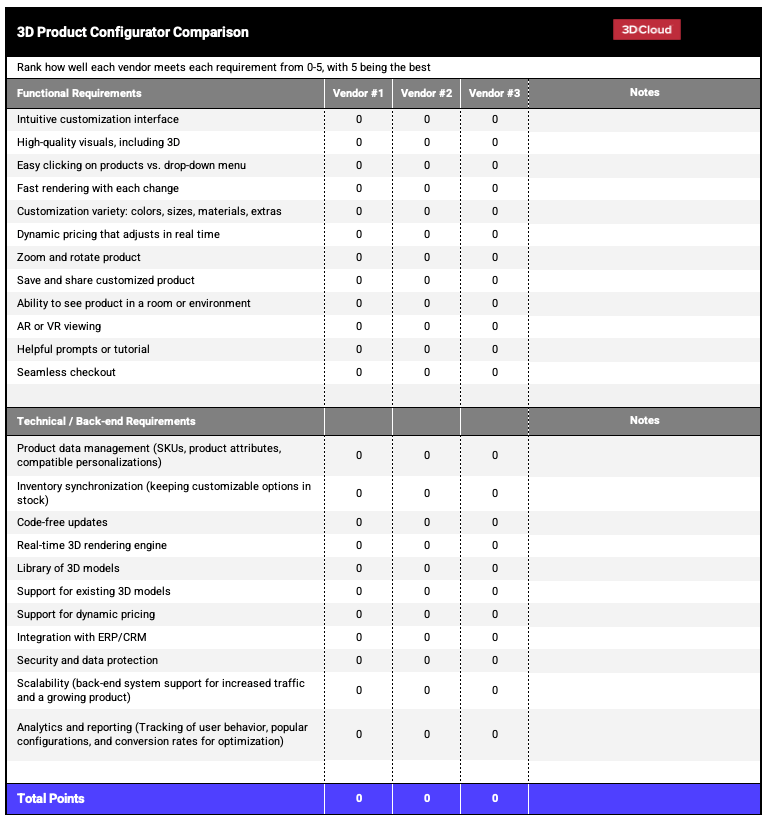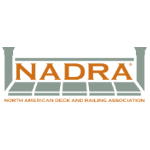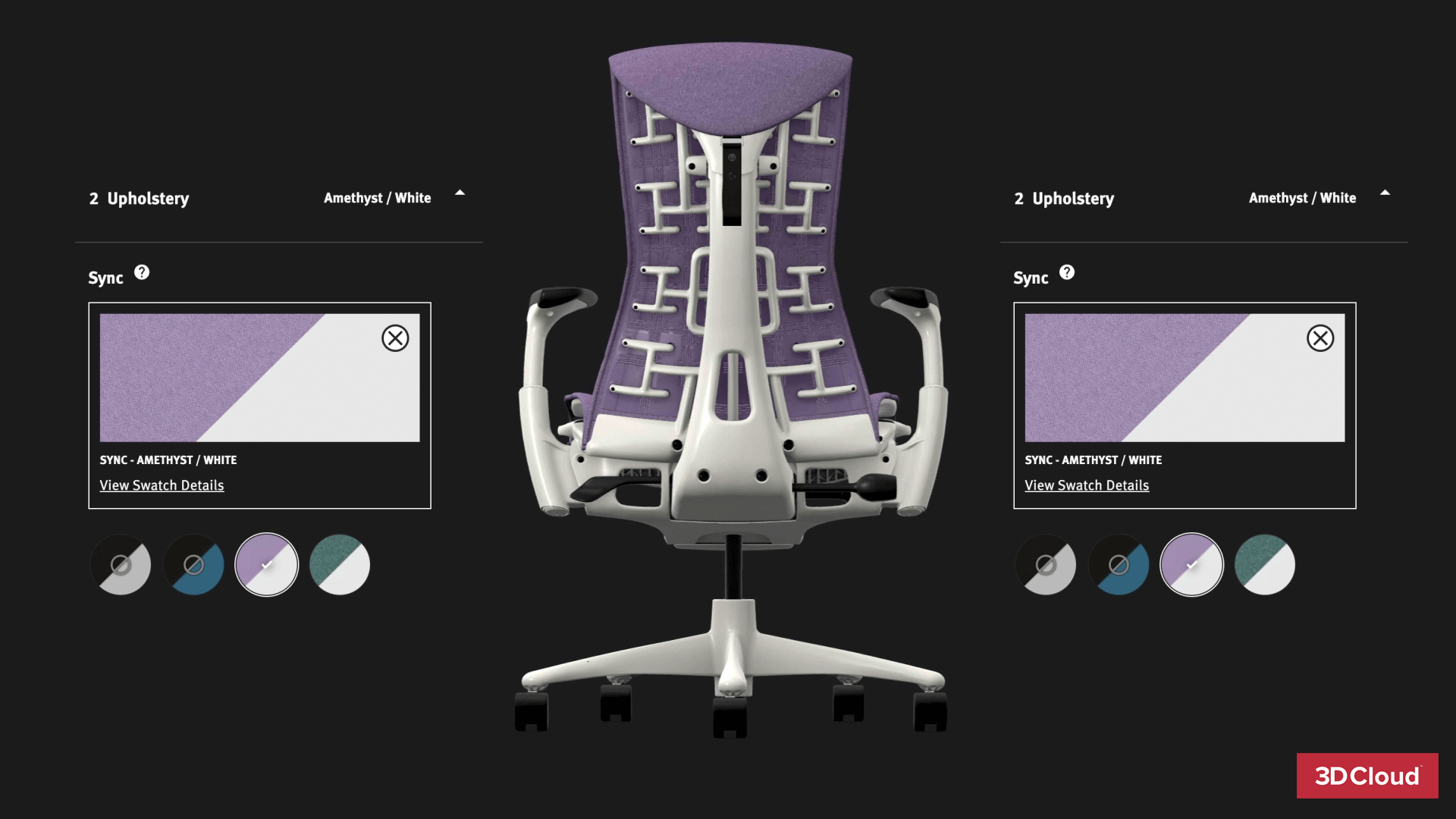
Customers want personalized products, and businesses can meet those needs with product configurators. Explore examples of how diverse companies use product configurators to drive sales and reduce costs. Also, get our free configurator comparison template.
Inside this article:
What is a product configurator?
A product configurator is a digital tool, often 3D, that allows shoppers to customize product features before making a purchase. Customers can adjust options such as color, size, or components and view a virtual preview. This enhances the buying experience and can boost sales. Industries such as furniture, fashion, electronics, and automotive use them.
In the furniture industry, customers use product configurators to design items such as sofas, beds, and chairs by selecting materials, colors, and shapes according to their preferences. Fashion retailers allow users to choose fabrics, colors, and styles to design their own clothing items. Electronics manufacturers allow users to customize laptops, smartphones, and other gadgets by selecting the specifications and components they need. Car shoppers use configurators to virtually build their cars by selecting various models, colors, engines, and features. These are just a few of the top industries using product configurators.
Key Takeaways:
- Product configurators allow customers to personalize and visualize products, enhancing their shopping experience and increasing satisfaction.
- Product configurators can help drive sales, increase brand loyalty, reduce waste, and optimize inventory management.
- Effective 3D product configurators feature user-friendly interfaces, real-time visualization, and mobile compatibility, improving customer engagement.
- Businesses can streamline the creation and maintenance of product configurators by using a 3D digital asset management platform to consolidate and distribute 3D assets.
Best product configurator examples
These 20 examples demonstrate how businesses across various industries utilize product configurators to sell their products. They use either visual or 3D product configurators to let website visitors customize their selections.
A 3D product configurator is a type of product configurator that allows customers to view and interact with products in a three-dimensional environment. On the other hand, a visual product configurator can refer to any configurator that provides a visual representation of the product being configured. These configurators can include 2D images or interactive visuals that allow customers to change the product’s colors, materials, or other features.
A 3D product configurator provides a more immersive and interactive experience for customers. Website product configurators typically feature user-friendly interfaces that help guide customers through various options, showing how a product’s appearance will change with different material selections and optional product customizations.
Here are innovative examples of brands that have leveraged visual and 3D product configurators to engage customers and improve their bottom lines.
Automotive product configurator examples
Automotive companies use product configurators to let customers customize their vehicles, choosing everything from the color to its interior.
- Adventure Wagon
Industry: Van and camper builds
Type of configurator: Visual product configurator
Problem solved: Create a custom van build
Product configurator for vans and campers

Adventure Wagon’s visual product configurator
The Adventure Wagon Configurator allows customers to design a camper van, tailoring it to their unique needs and preferences. The program offers a range of customization options, including bed size, layout, storage configurations, and options for adding a sink, stove, or refrigerator. Customers can also choose from a range of finishes and materials to personalize the look of their conversion kit.
- Lucid Motors
Industry: Automotive
Type of configurator: Visual product configurator
Problem solved: Allow customers to design their electric vehicles while reducing waste and optimizing the supply chain
Automotive product configurator
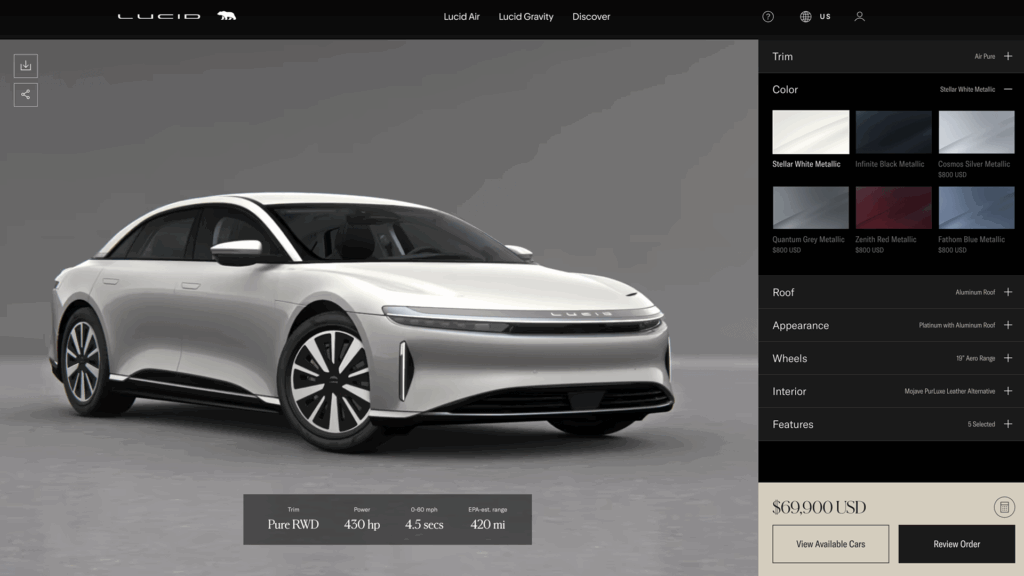
Lucid Motors’ visual product configurator
Lucid Motors, an electric vehicle (EV) manufacturer, offers car shoppers a visual product configurator. Lucid’s vehicle configurator enables customers to select and visualize colors, wheels, interiors, and other features on any of its four EV models. This approach gives shoppers a realistic sense of their potential next vehicle without setting foot on a lot.
Home product and furniture configurator examples
A designer or home improvement company can use a 3D visual product configurator to allow customers to design their kitchen and visualize how new office furniture will look by dragging and dropping furniture, windows, or other elements into a 3D representation of their space. Similarly, furniture product configurators might allow customers to design their ideal sofa or sectional.
- Raymour & Flanigan
Industry: Home furnishings and mattresses
Type of configurator: 3D sectional sofa configurator and room planner
Problem solved: Customers can visualize sofa options and virtually place furniture in a room before purchasing or even visiting a store
3D sectional configurator
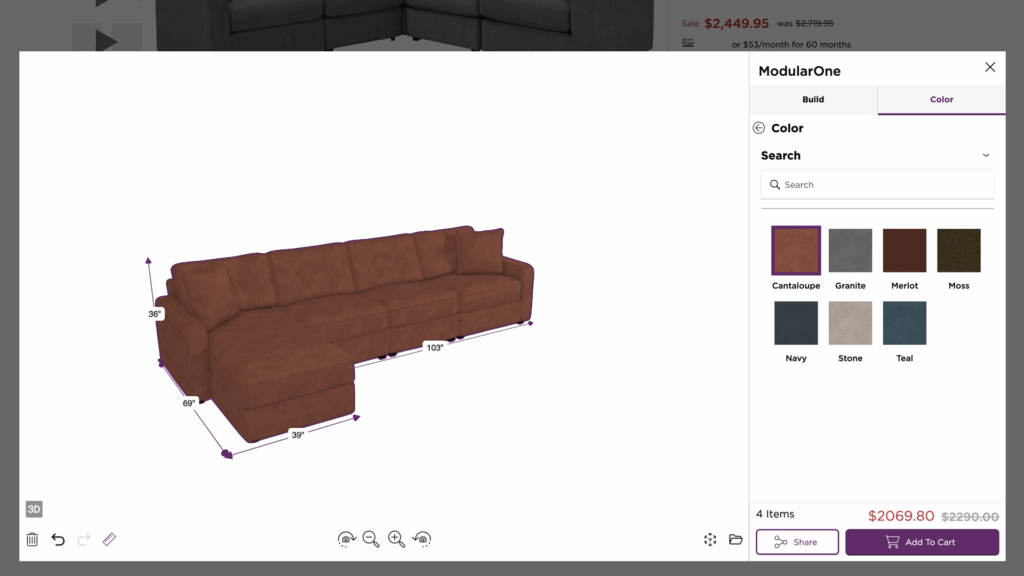
Raymour & Flanigan’s 3D sectional sofa configurator
Raymour & Flanigan is a Northeast-based furniture retailer that offers a 3D sectional sofa configurator as well as a room planner, 360 product spins, and WebAR. Shoppers can use the 3D sectional configurator to view multiple configurations, materials, and features, and then use the other tools to visualize furnishing options in a room.
“With more customers browsing online before visiting showrooms, the 3D Cloud Sectional Configurator helps us deliver a seamless experience,” says Katharine Martin, Senior Site Merchandiser for Raymour & Flanigan. “It’s one of many tools we use to provide consistent, top-notch service, connecting shoppers with our associates whether they start or finish their purchase online or in-store.”
- CITY Furniture
Industry: Home furnishings
Type of configurator: 3D room planner and furniture product configurator
Problem solved: Shoppers can design sofas and other furniture in various styles and colors – and see them within their room – before purchasing
Furniture product configurator and room planner
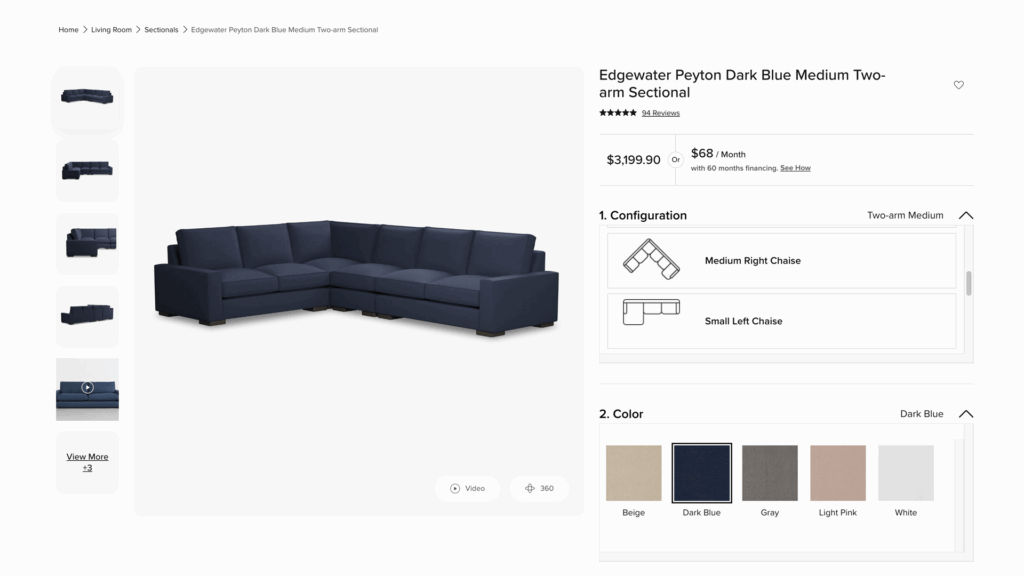
City Furniture’s 3D room planner
CITY Furniture’s full suite of 3D product visualization enables shoppers to choose among a wide range of options to design their sofa (or other furniture) and place it virtually in a room. The realistic 3D visuals enable customers to quickly try different options in real-time. Shoppers can use augmented reality (AR) to see the furniture in their own room. Andrew Koenig, the CEO at CITY Furniture, says, “This is the most efficient, most compelling approach to 3D available in furniture retail today.”
- Herman Miller
Industry: High-end office furniture
Type of product configurator: 3D product configurator
Problem solved: Provides customers with options to customize the company’s office chairs so they can create a product that truly fits their needsOffice furniture product configurator

Herman Miller online 3D product configurator
Herman Miller’s online 3D product configurator provides the ultimate experience for customizing an office chair. Customers can select everything from the chair color to the upholstery to adjustable arms. They can also choose seat depth, lumbar support, and the best wheels for carpet or hard floors. Users can see the price change based on their feature selections.
Offering online customization of its iconic chairs is only one way that MillerKnoll, the parent company of Herman Miller, uses 3D product configurators. MillerKnoll explains, “[The configurator] is completely code-free. This means we can move faster, spend less time and money maintaining configurators, and give designers and consumers what they crave most – the power to configure and visualize their designs.”
- Lowe’s
Industry: Home improvement
Type of product configurator: 3D room planner and product configurator
Problem solved: Customized product: Allows customers to imagine their new kitchen before investing in a renovation 3D product configurator and room planner
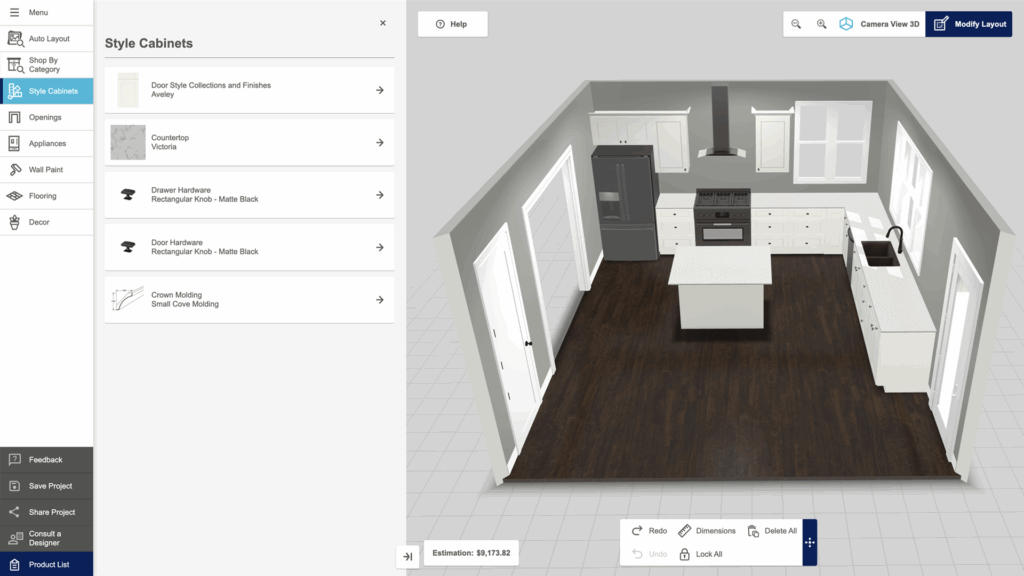
Lowe’s Kitchen Planner 3D product configurator
With Lowe’s Kitchen Planner, customers can design and visualize their kitchen remodel project, including customizing the layout, cabinets, appliances, and finishes. The online configurator solves the customer’s problem of imagining how their new kitchen will look and feel before investing in a costly renovation. The 3D product configurator reduces the likelihood of costly mistakes and increases customer satisfaction by giving them a realistic preview of their new kitchen. Additionally, Lowe’s saves time and money by reducing the need for in-person consultations and showroom space.
- HON
Industry: Office furniture
Type of product configurator: 3D room planner and product configurator
Problem solved: To design and visualize the placement of office furniture before purchase
Office 3D room planner for office furniture

HON 3D room planner and product configurator
Hon, owned by HNI Corporation, has an office furniture room planner and product configurator to personalize a wide range of cabinets, chairs, sofas, tables, desks, and other office furniture. The room planner offers 2D and 3D views, along with options for floors, wall colors, décor, lighting, and more. Dimensions can be adjusted to match the available space. Users can start from sample rooms or templates, or build a floor plan from scratch.
Beauty and fashion product configurator examples
Beauty and fashion brands use product configurators to allow customers to personalize everything from clothing measurements and colors to product packaging (such as perfumes) and more, creating one-of-a-kind looks.
- Brilliant Earth
Industry: Jewelry
Type of configurator: Visual product configurator
Problem solved: Offer a personalized shopping experience to customize an engagement ring to fit your style, budget, and ethics
Jewelry product configurator
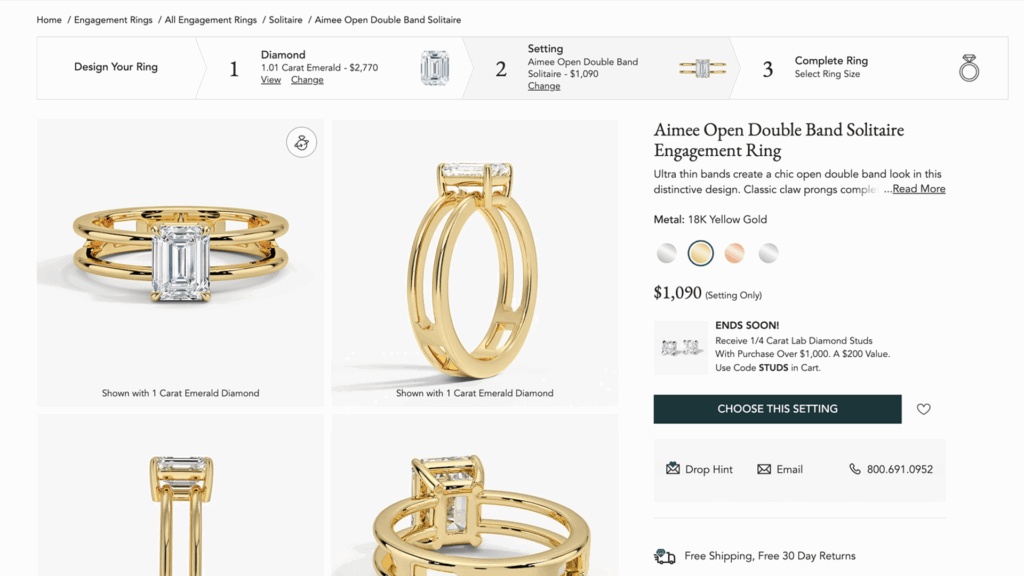
Brilliant Earth’s Engagement Ring Product Configurator
Online jewelry retailer Brilliant Earth specializes in ethically sourced engagement rings and gemstones. The company launched a product configurator that allows customers to design their own engagement rings by choosing from various diamond shapes, diamond quality, and settings. Customers can also examine the source of the diamonds to select a ring that matches their personal environmental and ethical standards.
Brilliant Earth’s configurator allows customers to see their ring design in 3D and adjust the diamond and setting. They can also customize their engagement ring to their exact specifications, ensuring that they get a beautiful and ethical product. Shoppers can easily visualize how their choices affect the final product.
Beth Gerstein, Co-founder and CEO of Brilliant Earth, states, “Our product configurator was a game-changer for us. It gave our customers the freedom to create their own unique engagement rings that reflect their values and personality. The ability to customize our products was a key factor in launching Brilliant Earth and sustaining our growth. We offer our customers a unique and personalized experience while enabling our customers to make ethical choices, which is what sets us apart from other jewelers.”
- Converse
Industry: Footwear
Type of configurator: Visual product configurator
Problem solved: Design and personalize your shoe to create a unique productProduct configurator for shoes

Converse visual product configurator
Converse offers a visual product configurator called “Converse by You,” which allows customers to design their shoes by choosing from various colors, patterns, and materials. They also offer the option to add personalized text to the shoe design. This customization process enhances their experience and allows them to express their individuality. It also differentiates Converse from other shoe brands by offering unique, one-of-a-kind products.
- eShakti
Industry: Fashion
Type of configurator: Visual product configurator
Problem solved: Design made-to-order, customized clothes and reduce the fashion industry’s environmental impact
Product configurator for clothes

eShakti’s visual product configurator
eShakti, a women’s online fashion brand, implemented product configurators as a key part of its business strategy. Customers use eShakti’s fashion visual configurator to personalize their clothing items according to their preferences and specific measurements. eShakti’s customers can design clothes that perfectly fit their body shape, style, and preferences. Shoppers input their exact measurements and preview the final design before ordering, reducing returns. eShakti’s website product configurator also aligns with its commitment to sustainability. By offering made-to-order clothing items, the brand avoids overproduction and waste. Instead, they only produce items that customers order.
- Guerlain
Industry: Fragrance and skincare
Type of configurator: Visual product configurator
Problem solved: Bespoke fragrance bottle enhances the luxury experience
Fragrance bottle product configurator

Guerlain’s visual fragrance product configurator
Guerlain is a luxury skincare and perfume designer that strives to offer sustainable fragrance, beauty, and skincare solutions. Customers can use Guerlain’s fragrance product configurators to customize the bottle and packaging of any perfume to make it truly one-of-a-kind. This personalized service creates an exclusive and memorable experience, enhancing brand loyalty and awareness and establishing Guerlain as a luxury brand that values individuality.
- iTailor
Industry: Fashion
Type of configurator: Visual product configurator
Problem solved: Allow customers to customize their garments according to preferences and specific measurements and streamline the production processFashion product configurator

iTailor’s visual product configurator
iTailor is an online retailer that offers made-to-measure suits and shirts. Shoppers can use iTailor’s visual suit configurator to personalize their garments based on their preferences and measurements. Furthermore, iTailor’s product configurator helps streamline its production process and reduce waste. By producing only the items customers order, they avoid overproduction and don’t accumulate unnecessary inventory.
Product configurator examples for consumer goods
Consumer goods companies that offer everything from guitars to whisky allow shoppers to create personalized products.
- Emerald Guitar
Industry: Musical Instruments
Type of configurator: Visual product configurator
Problem solved: Provides customers with the ability to customize and design a guitar
Guitar product configurator
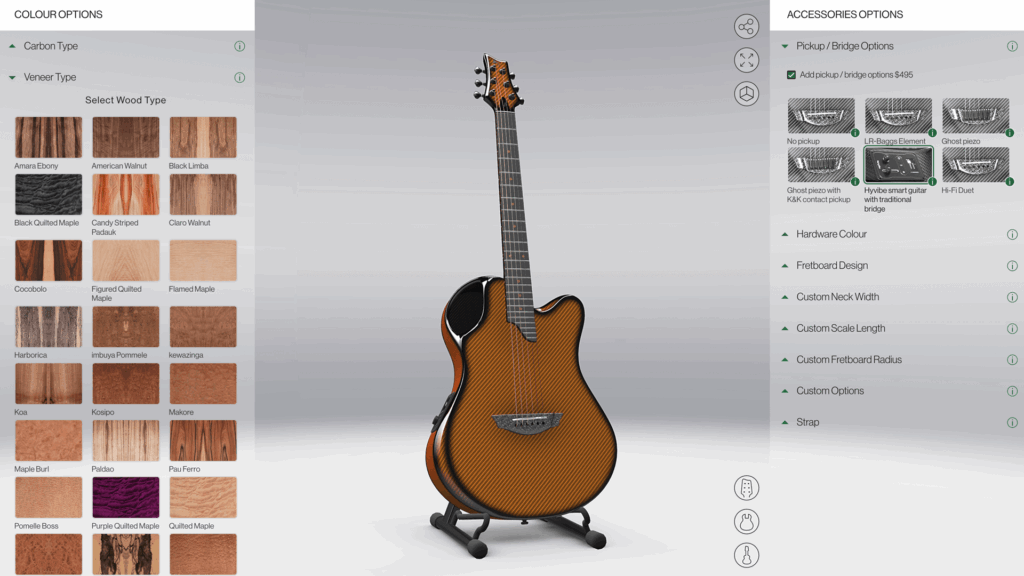
Emerald Guitar’s visual product configurator
Emerald Guitar’s 3D product configurator gives customers the power to design a unique guitar. For example, they can select the type of wood, hardware, and finish, allowing for a special instrument that fits their preferences and style. The visual configurator also allows customers to see a 3D preview of their guitar design before making a purchase.
- Whisky Blender
Industry: Whisky
Type of configurator: Visual product configurator
Problem solved: Provides an interactive and personalized experience for customers to create their whisky blend
Product configurator for whisky
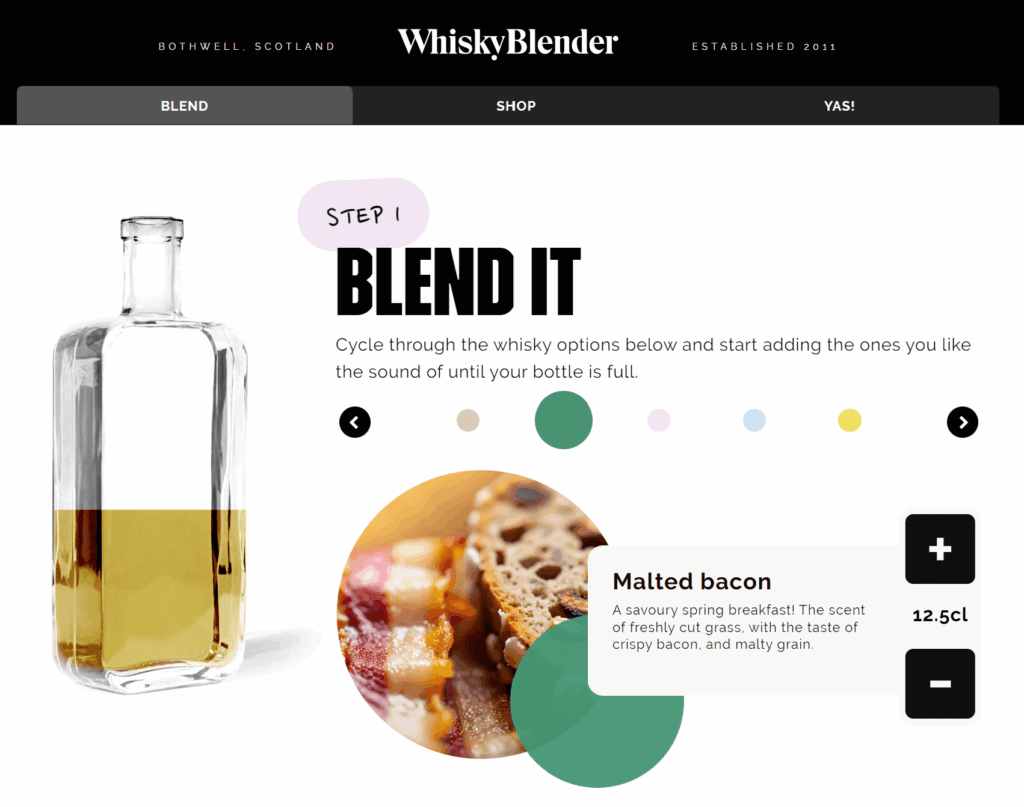
Whisky Blender’s Digital Blender visual product configurator
At Whisky Blender, customers can create a personalized whisky blend with a unique product configurator. By selecting from various single-malt whiskies, shoppers can experiment with different flavors and proportions to create a bespoke blend. The digital platform also provides information on each single malt whisky’s characteristics and tasting notes, allowing them to make informed choices. This personalized and educational experience enhances customer engagement and loyalty, positioning Whisky Blender as a premium whisky brand that values craftsmanship and innovation.
Examples of online product configurators for sporting goods
Sporting goods companies offer shoppers the ability to customize many aspects of their products, whether it’s the fit of a bike or the grip of a racquet.
- Fanatik Bike
Industry: Mountain bikes
Type of configurator: Visual product configurator
Problem solved: Create a tailor-made bike by selecting from a range of customizable components
Mountain bike product configurator
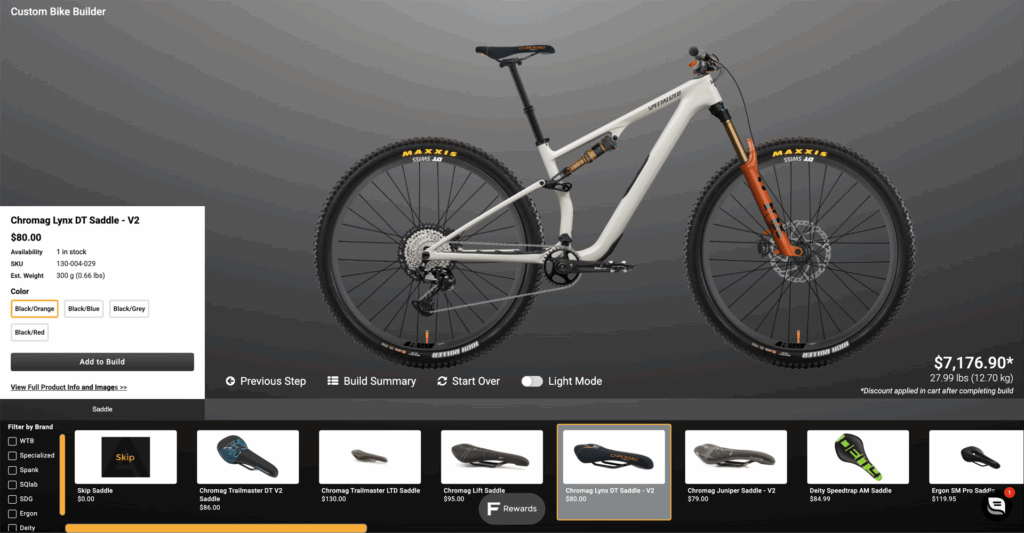
Fanatik Bike’s visual product configurator
Fanatik Bike’s visual product configurator, the “Bike Builder,” allows customers to create a custom bike by selecting from a range of customizable components, including frame, fork, wheels, drivetrain, and suspension. The website product configurator offers real-time visualizations of the bike as shoppers select each part, giving them a clear idea of how the final product will look. This personalized and interactive experience helps customers design their dream bike, simplifying the purchasing process by ensuring that all selected parts are compatible and meet their needs and preferences. The configurator also increases customer engagement and satisfaction, as they can see their creation come to life before their eyes.
- Wilson
Industry: Sporting equipment
Type of configurator: Visual product configurator
Problem solved: Customize popular sporting equipment
Tennis Racket Product Configurator

Wilson’s visual product configurator
Wilson is a sports equipment and apparel brand in business for over 100 years. Wilson’s visual product configurator helps sports enthusiasts customize a range of sports equipment and apparel, such as golf clubs, basketballs, footballs, soccer balls, volleyball nets, and team uniforms. Customers can choose from various customization options, such as colors, designs, logos, and personalization. For example, golfers can personalize their golf balls with their name or initials. Basketball players can design a custom basketball with their team colors and logo. Volleyball teams can create custom team uniforms featuring their names and numbers.
Examples of other industries that use product configurators
Product configurators have become a critical tool in e-commerce strategy across diverse sectors. For example, consumers can use the tool to design structures, customize tools, and design digital signs.
- Countryside Barns
Industry: Outdoor structures
Type of configurator: 3D product configurator
Problem solved: Visualize a shed design before purchasing
Outdoor shed product configurator

Countryside Barns 3D Product Configurator
Countryside Barns’ 3D product configurator allows customers to design and customize barns or outdoor structures, choosing the size, style, color, and features that best suit their needs. This interactive tool helps shoppers visualize their design before purchasing, thereby reducing errors and misunderstandings, streamlining the ordering process, and improving overall customer satisfaction. Additionally, Countryside Barns can offer a broader range of customization options and compete with larger, more established competitors.
- Leatherman
Industry: Multi-tools
Type of configurator: Visual product configurator
Problem solved: Offer customized multi-tools that are not available in stores
Tool product configurator
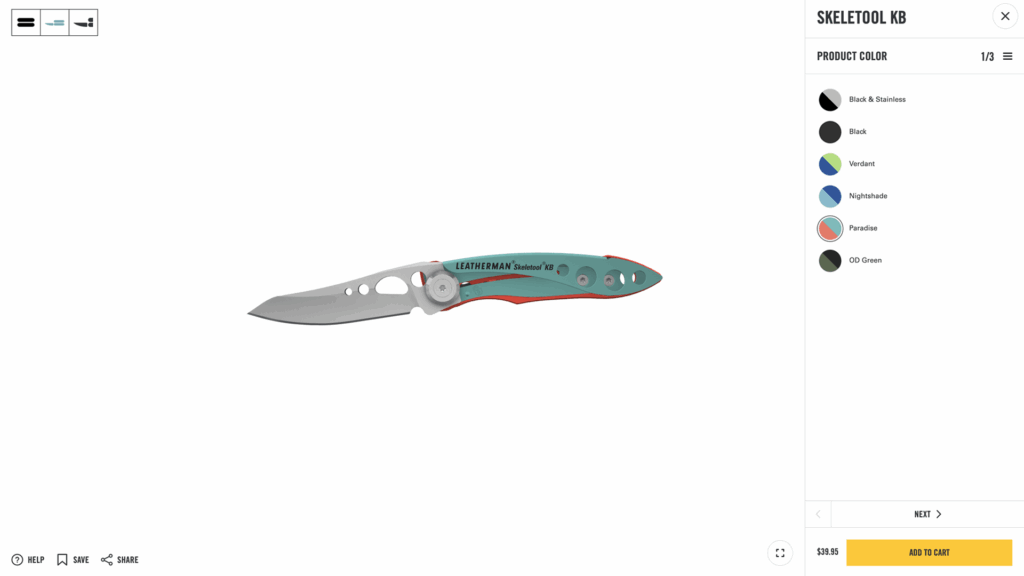
Leatherman’s visual product configurator
Leatherman’s Custom Shop allows consumers to create a personalized multi-tool that meets their needs and preferences. They can use the service to choose from various handle colors and engraving options to make the multi-tool unique. While customers cannot change the specific tools included in the multi-tool, the customization options available in the Custom Shop offer a level of personalization that is not available with standard off-the-shelf multi-tools.
- Snap-On
Industry: Automotive repair and maintenance tools
Type of configurator: Visual product configurator
Problem solved: Customize tool-storage products per each customer’s preferences and needs
Product configurator for tool storage
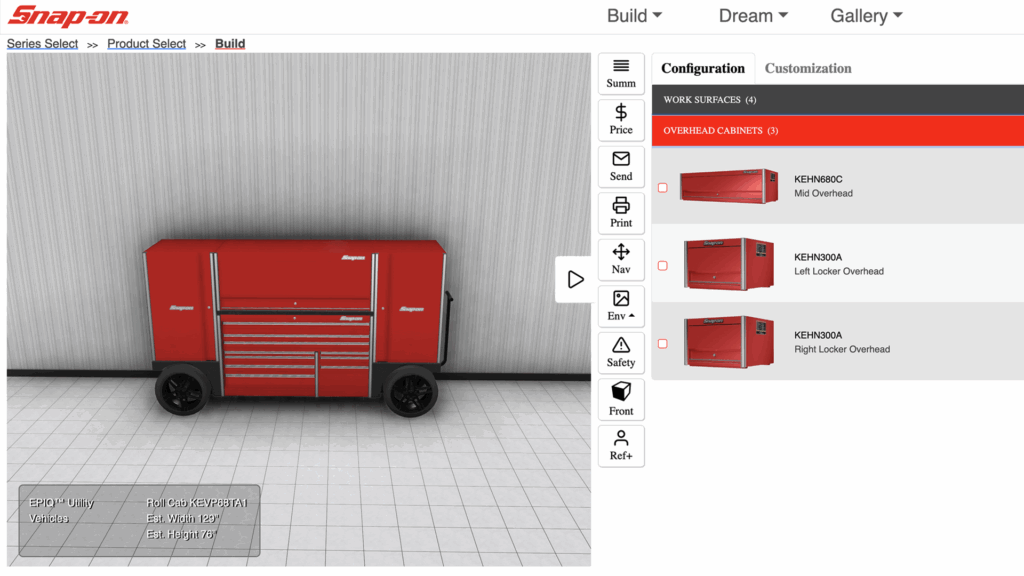
Snap-on’s visual product configurator
Snap-on’s visual product configurator allows customers to design their tool storage solutions, selecting from a range of toolboxes, cabinets, and accessories and previewing the final product before purchasing. This tool helps shoppers create a personalized and optimized workspace while reducing the need for physical inventory and showroom space.
- TimberTech
Industry: Decking
Type of configurator: 3D product configurator
Problem solved: Help customers visualize and customize their decking projects
Decking product configurator
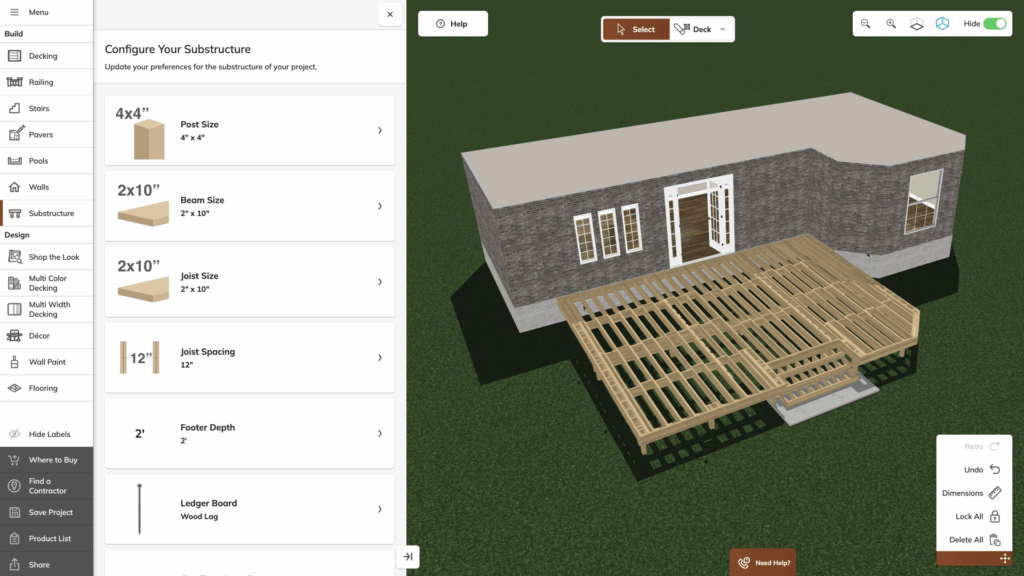
TimberTech 3D Deck Designer and product configurator
TimberTech manufactures high-quality composite decking, railing, and lighting solutions. TimberTech’s 3D Deck Designer helps customers visualize and customize their decking projects. In the Deck Designer, users can select options such as board color, width, texture, and length, as well as add-ons like railings, lighting, and fasteners. This interactive experience allows customers to experiment with different design options and make informed decisions about their decking needs.
Common elements of the best product configurators
The best product configurators have an intuitive user interface, real-time 3D visualization, and many customization options. They work well on mobile, provide seamless checkout, and feature robust back-end systems. The back-ends manage data, rendering, and content updates. Ultimately, a good product configurator serves both the customer and the business.
Next, we dive more into the key elements of product configurators from both the customer and back-end perspectives.
Important product configurator elements from the customer’s perspective
The top product configurators share common elements like an intuitive interface, realistic 3D visualization, and dynamic pricing. They offer a wide range of customization options, mobile responsiveness, and seamless checkout. They also guide customers with helpful prompts and save-and-share functionality.
Here’s a more detailed look at important product configurator elements for customers:
- Intuitive user interface: Simple interface where shoppers can choose and change options easily.
- Real-time visualization: High-quality visuals (often 3D) that reflect changes immediately and provide a realistic product view.
- Customization variety: A wide range of options (colors, sizes, materials) that allow users to personalize the product according to their preferences.
- Live price updates: Dynamic pricing that adjusts in real time based on customization choices.
- Mobile optimization: Responsiveness across smartphones, tablets, and desktops.
- Guided assistance: Helpful prompts, FAQs, or tutorials to guide customers through complex configurations.
- Save and share options: The ability to save configurations for future reference or share them with others.
- Seamless checkout: Smooth transition from the product configurator to the shopping cart, with all customizations intact.
Key product configurator elements from a back-end perspective
Top product configurators feature robust back-end systems that manage product data, integrate with CRMs, and enable easy updates. This ensures configurators remain agile and user-friendly. Back-end systems also should be fast, secure, and scalable.
Here’s a closer look at key elements of a product configurator’s back-end system:
- Product data management: Efficient handling of SKUs, product attributes, and options for ensuring accurate customization.
- Code-free updates: Allowing non-technical users to update materials without technical support.
- Real-time rendering technology: Fast, responsive 3D visualization engines.
- Integration with ERP/CRM: Seamless connections to enterprise resource planning (ERP) or customer relationship management (CRM) systems for syncing customer data, inventory, and orders.
- Inventory synchronization: Keeping customizable options in stock and quickly updating availability.
- Dynamic pricing logic: Rules-based pricing algorithms that adjust costs based on customizations.
- Security and data protection: Secure handling of user data and customization preferences, compliant with privacy laws like GDPR.
- Scalability: Back-end system support for increased traffic and a growing product catalog without performance issues.
- Analytics and reporting: Tracking user behavior, popular configurations, and conversion rates for optimization.
- Testing and compatibility checks: Systems for testing product combinations to ensure compatible features and prevent errors.
Why use a product configurator?
Product configurators let customers personalize products, see changes right away, and avoid mistakes. They make shopping more fun. For businesses, they increase sales, save time, cut waste, and lower costs. Both customers and companies benefit from using product configurators.
Here are the key benefits of product configurators for customers:
- Personalize and visualize products
With a product configurator, customers have a role in designing key components of the product they will buy and customizing how it looks. Furthermore, an Epsilon study on the impact of personalization marketing found that 80% of respondents are more likely to buy from a company that offers a personal experience.
- Enjoy a more engaging shopping experience
Product configurators bring a new dimension to the traditional e-commerce experience. Instead of just scrolling through 2D visualizations and pictures, a customer can click on a product and see it from all angles. The experience more closely resembles in-store shopping.
- Be a better shopper
The 3D Cloud Furniture Shopping Trends Study 2025 found that two-thirds of shoppers who didn’t use a 3D visualizer or configurator when buying furniture wish they had. Almost three-quarters want to use these tools every time they shop for furniture. And more than three-quarters feel that using 3D visualization or configuration makes them better at buying furniture. In short, 3D product configurators improve buyer confidence.
- Return fewer items
With a high degree of personalization, customers are less likely to return products. According to Optoro’s 2021 Retailer Guide to Holiday Returns, returns cost businesses approximately 66% of the item’s original price.
Here are the benefits of product configurators for manufacturers and retailers:
- Save time and money
Product configurators save manufacturers time and money while increasing efficiency, accuracy, and profits. When a manufacturer allows customers to design the product they will buy, it can help them avoid pursuing pathways for products that customers don’t like or will return.
- Increase sales
Product configurators boost sales by offering customers a more personalized, interactive shopping experience. According to McKinsey’s 2021 Next in Personalization Report, companies that excel at personalization generate 40 percent more revenue than average players.
- Stay competitive
Manufacturers use product configurators to customize products on demand and quickly respond to changing consumer demands. Companies can also collect valuable customer data and insights, informing product development and marketing strategies.
- Optimize the supply chain
Configurators provide detailed information about specifications and preferences, helping businesses optimize inventory management. Many companies felt the crunch from supply chain issues during the COVID-19 pandemic and are focusing on how it relates to their online strategies. A 2020 Gartner report titled “Four Steps to Become a Customer-Centric Supply Chain” found that 83% of business leaders said the supply chain is key to enhancing customer experience.
- Prioritize sustainability
Some companies use product configurators as a central part of their business model, only producing customer orders. As a result, they save resources on products they may not sell and impress customers. According to McKinsey Sustainability, the savings in resource costs can improve operating costs by up to 60%.
- Improve customer loyalty
Product configurators enhance customer loyalty by offering personalized products that meet individual preferences, leading to higher customer satisfaction and a higher likelihood of repeat purchases. In fact, Twilio’s 2021 State of Personalization found that 60% of consumers will become repeat customers after having a personalized experience.
- Save money on returns and exchanges
Using product configurators can reduce the cost of returns and exchanges for businesses.
How to choose a product configurator for a business
To select a product configurator, first define business needs, check user experience, and assess back-end strength. Ensure it integrates with existing systems, allows customization, and handles growth. Ask for demos and references before making a decision.
Here are detailed steps any business can follow to choose a product configurator wisely:
- Identify customer needs and preferences: Start by understanding your target customers’ needs. Determine which customization options they most value to ensure the configurator enhances their experience.
- Research competitor configurators: Investigate how competitors use configurators to engage customers. Identify their strengths and weaknesses to inform your decisions and ensure competitiveness.
- Analyze the products that could benefit from a configurator: Identify which products would benefit the most from customization.
- Assess the level of customization you’ll want in a product configurator: Consider whether an off-the-shelf configurator meets your needs or if a custom-built solution is necessary to stay competitive. Businesses with simpler customization needs may select off-the-shelf options, while those with complex products may require a more tailored approach. Since most businesses lack in-house expertise, they will likely work with a vendor.
- Set clear business goals: Establish objectives such as increasing sales, improving customer satisfaction, managing inventory, or reducing product returns. Align these goals with the broader business strategy and use them to measure the configurator’s success.
- Research and begin evaluating potential vendors: Begin researching and evaluating vendors that specialize in product configurators. Look for vendors with experience in your field if possible. Check their reputation for reliability and follow-up support.
- List your technical and functional requirements: Define the configurator’s technical needs, including scalability, speed, and code-free updating. Also, list your functional requirements, including items like realistic 3D visualization, dynamic pricing, and an intuitive user interface.
- Engage with stakeholders: Involve key teams (e.g., IT, marketing, product management) to ensure the configurator requirements meet internal and customer-facing needs.
- Request vendor demos and references: Vendor demos should be scheduled to observe configurators in action, facilitate questions, and evaluate each vendor against specified technical and functional requirements. Also, ask for references from previous clients to confirm the vendor’s track record in delivering successful projects and ongoing support.
- Rank your vendors with your requirements scorecard: Use your research to rank how well each vendor meets your functional and technical requirements.
- Ask for proposals from your top vendor candidates: Request detailed proposals from the top vendors. Ensure the proposals include pricing, timelines, support plans, and any customizations required to meet your business needs.
- Negotiate with your top vendor: Overlay the proposals with the requirements scorecard to select which vendor to negotiate with. If that negotiation stalls, consider negotiating with your #2 candidate.
Downloadable Product Configurator Comparison Template
Download this Product Configurator Comparison Template for Excel
Tips for implementing product configurators
Successfully implementing a product configurator requires strategic planning, testing, and continuous refinement. Whether businesses are building a simple or complex configurator, these tips will help ensure a smooth and successful implementation.
- Develop a prototype or MVP (when applicable)
Developing a prototype or minimum viable product (MVP) can be highly beneficial for businesses with complex products or unique customization requirements. A prototype allows internal teams to test key features, user flows, and integration before full deployment. This is particularly useful if the configurator involves advanced 3D visualization or multiple integration points with existing systems, such as ERP or CRM. This step may not be necessary for simpler products or off-the-shelf configurators; the focus can then shift to early testing and monitoring instead.
- Test for usability and performance
Regardless of whether a prototype was developed, thorough testing is crucial before the full launch. Test the configurator for ease of use, speed, and performance across all devices. Ensure the user interface is intuitive, customization options are accessible, and that the configurator can handle traffic spikes. Testing should also focus on preventing bottlenecks in user flow, ensuring that customers don’t encounter delays or errors during the customization process.
- Monitor performance and optimize
After launch, closely monitor the configurator’s performance. Use tools to track metrics such as page load times, conversion rates, and user interaction. If bottlenecks or inefficiencies are detected, make adjustments to improve responsiveness and the overall user experience. For example, streamline customization steps if users drop off at specific points in the journey.
- Track KPIs (Key Performance Indicators)
Continuously track key metrics such as usage, conversion, and customer feedback. These indicators provide valuable insights into how well the configurator is meeting business goals. By identifying trends and pain points, businesses can make data-driven decisions to improve the configurator’s effectiveness.
- Regularly update and improve the configurator
Regularly update the configurator based on user behavior and changing business needs to ensure it stays relevant. Adding new customization options, improving the user interface, or integrating emerging technologies, such as AR, can keep the configurator fresh and engaging. Regular updates also help adapt to evolving customer expectations and product offerings.
- Gather customer feedback and adapt
Seek feedback from customers about their experience with the configurator. This feedback offers valuable insights into potential friction points that may not be apparent from the data alone. If customers suggest new features or report usability issues, use this information to inform future updates and improve satisfaction.
- Provide ongoing support and training
Once the configurator is live, ensure that the internal teams responsible for managing and maintaining it have adequate training and resources. Ongoing vendor support is also essential to troubleshoot any technical issues that arise. A well-maintained configurator ensures smooth operation and a positive customer experience.
The strategic impact of product configurators
The strategic impact of online product configurators is significant for businesses in various industries. They boost customer satisfaction, sales, margins, and competitiveness. Overall, they help companies have a stronger position in the market.
Many brands have taken innovative approaches to 3D product configuration, recognizing its potential to enhance customer experience and drive sales. From furniture and fashion retailers to car and electronics manufacturers, companies are investing in advanced configurator technologies that offer new levels of customization, interactivity, and personalization.
Online product configurators allow companies to offer a level of customization and personalization that was previously impossible with traditional sales channels. Companies can tailor their offerings to meet individual customer needs and preferences by allowing consumers to configure and customize products online.
 “Online product configurators are essential for retailers and manufacturers of highly configurable products such as furniture, kitchen, bath, decking, and storage,” says Beck Besecker, CEO and Co-Founder of 3D Cloud. “They allow brands to create a personalized and engaging shopping experience for customers while also improving operational efficiency and reducing costs. With 3D product configurators, companies can deliver a new level of customization and personalization.”
“Online product configurators are essential for retailers and manufacturers of highly configurable products such as furniture, kitchen, bath, decking, and storage,” says Beck Besecker, CEO and Co-Founder of 3D Cloud. “They allow brands to create a personalized and engaging shopping experience for customers while also improving operational efficiency and reducing costs. With 3D product configurators, companies can deliver a new level of customization and personalization.”
Online product configurators can have a range of benefits for companies, including increased customer satisfaction and loyalty, higher sales volumes, and improved margins. Companies can foster a sense of ownership and pride in the product, customer loyalty, and repeat business by allowing customers to create products tailored to their needs and preferences. By automating the configuration and ordering process, companies can reduce the need for sales staff and eliminate errors and delays in the ordering process.
A 2023 paper, “Potential of Mass Customization using Product Configurators,” presented at the International Symposium INFOTEH-JAHORINA, explores how product configurators enable businesses to offer personalized products at scale. The authors write, “Product configurators enable organizations to produce numerous customized items while simultaneously maintaining control over the design and manufacturing processes.”
3D product configurator for streamlined multi-platform production
A 3D product configurator provides numerous benefits to a business. However, to get the most out of a product configurator, it must be easy to implement and update, compatible with existing assets, and seamlessly integrated with all sales outlets.
3D Cloud transforms product visualization and customization across office, kitchen, bath, storage, outdoor, and furniture verticals. The 3D Cloud Product Configurator with WebAR OnDemand works seamlessly on any device, allowing customers to configure products and generate a bill of materials instantly for manufacturers.
With a centralized Digital Asset Management System (DAM) and SIF Integration, 3D Cloud ensures high-quality, reusable 3D assets while streamlining product specifications with dealers. A single 3D asset library enables easy deployment across multiple platforms.
Built for large-scale catalogs and global brands, 3D Cloud supports billions of product configurations, enhancing customer engagement and driving conversions. Trusted by Allsteel, Geiger, La-Z-Boy, Kimball, and Herman Miller, 3D Cloud helps businesses boost sales and optimize 3D content strategy.

